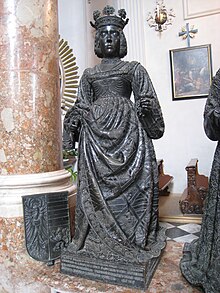Elisabeth of Luxembourg, Queen of Bohemia
| Elizabeth of Luxembourg | |
|---|---|

Statue of Elizabeth at Hofkirche, Innsbruck
|
|
| Queen consort of Hungary | |
| Tenure | 1437–1439 |
| Coronation | 1 January 1438, Székesfehérvár |
| Queen consort of Germany | |
| Tenure | 1438–1439 |
| Queen consort of Bohemia | |
| Tenure | 1438–1439 |
| Coronation | 29 June 1438, Prague |
| Born | 7 October 1409 Visegrád, Hungary |
| Died | 19 December 1442 (aged 33) Győr, Hungary |
| Burial | Székesfehérvár Basilica, Hungary |
| Spouse | Albert II of Germany |
| Issue |
Anne, Duchess of Luxembourg Elizabeth, Queen of Poland Ladislaus the Posthumous |
| House | House of Luxembourg |
| Father | Sigismund, Holy Roman Emperor |
| Mother | Barbara of Cilli |
| Religion | Roman Catholic |
Elizabeth of Luxembourg (7 October 1409 – 19 December 1442) was queen consort of Germany, Hungary and Bohemia.
The only child of Holy Roman Emperor Sigismund, King of Hungary and Bohemia, Elizabeth was expected to ascend his thrones along with her husband, Albert of Austria. Her rights were ignored by the Hungarian nobility when Sigismund died in 1437 and only her husband was accepted as monarch, with Elizabeth as mere consort.
Albert died in 1439, leaving Elizabeth a pregnant dowager with two daughters, Anne and Elizabeth. Bohemian nobility proclaimed an interregnum, while King Vladislaus III of Poland was crowned new king of Hungary in May 1440, three months after Queen Elizabeth delivered a son, Ladislaus the Posthumous. She was determined to contend for her patrimony on her son's behalf, which led to a civil war between hers and Vladislaus' supporters. The conflict ended with the queen's death at the age of 33. Vladislaus himself died in battle in 1444, opening the path for Elizabeth's son to be recognized as king of Hungary.
Her real birth date can be calculated by virtue of a letter of King Sigismund to Kéméndi Péter fia János (John, son of Peter Kemendi), Lord-lieutenant of Zala County dated 26 April 1410 (sabbato post festum s. Georgii) at Végles, Hungary (now Vígľaš, Slovakia) and sealed with Queen Barbara's seal, who also stayed there and in which the king informs him about his daughter's birth alias circa festum beati Francisci confessoris. Because this feast falls on 4 October, it must have happened in the previous year, that is, 1409 and in October. Baranyai (1926) argues that the usage of circa can allow some variations towards September but if it had occurred in September, he would have referred to the feast of Saint Michael which falls on 29 September instead of that of Francis of Assisi. The only remaining question, namely the exact day is educed from the engagement date of his daughter to Archduke Albert which was held on 7 October 1411, Pozsony,Hungary (now Bratislava, Slovakia, Pressburg in German) and probably may have adjusted to a former important event because it belongs to no religious feasts. The birthplace is also inferential and is traced back to the traditional place for the queen's labours that was in Visegrád and which is referred to in her Memoirs by Helene Kottannerin in the case of Queen Elisabeth advanced in pregnancy with Ladislas V in early 1440. In addition, Itinerary of King Sigismund shows that he stayed in Visegrad between 9–19 October 1409. In the end one concludes that her birth in Prague, on 28 February 1409, similarly to the date of 27 November this year which in reality was her christening day, is based on false sources.
...
Wikipedia
